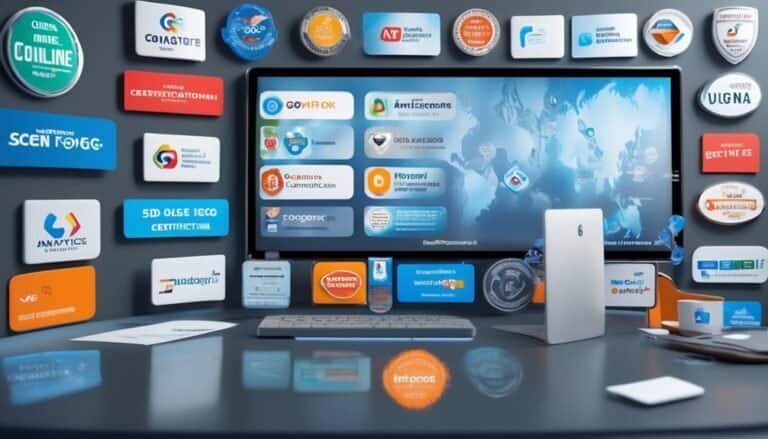Navigating the Challenges of Remote Team Leadership
In today's rapidly evolving work landscape, remote team leadership has become a critical skill set for managers and leaders.
The shift towards remote work has brought about a unique set of challenges that require a nuanced approach to leadership. From managing different time zones and building trust without physical presence to ensuring effective communication and maintaining team cohesion, the complexities of leading remote teams are multifaceted.
In this dynamic environment, leaders must be adept at adapting their leadership style and leveraging technology to foster productivity and collaboration.
As organizations continue to embrace remote work, understanding and navigating these challenges is paramount for effective leadership in the modern workplace.
Key Takeaways
- Recognize the unique challenges of remote work and provide support and resources to overcome them.
- Address the physical gap between team members through effective communication strategies.
- Empower team members to make decisions independently and foster autonomy and trust within the team.
- Clearly communicate goals, expectations, and deadlines to ensure alignment and productivity.
Time Zone Management
Managing time zones in a remote team setting presents logistical and communication challenges that require careful planning and coordination. Meeting scheduling and productivity can be significantly impacted when team members are spread across different time zones. The need for flexibility and coordination becomes paramount in ensuring that all team members can actively participate in meetings and collaborative work, while also maintaining a healthy work-life balance.
To address these challenges, leaders must prioritize effective communication and utilize technology to bridge the gap. Implementing flexible meeting schedules that accommodate different time zones can enhance productivity and engagement. Additionally, providing clear guidelines for availability and response times can help team members understand each other's working hours and foster a sense of respect for boundaries.
Furthermore, establishing a centralized communication platform can streamline collaboration and ensure that information is readily accessible to all team members regardless of their location. Encouraging open dialogue about time zone challenges and collectively finding solutions can foster a supportive and inclusive remote work environment.
Building Trust Remotely
Building trust remotely is a critical aspect of leading a remote team.
Virtual team bonding and remote communication strategies play a crucial role in establishing trust among team members.
In the following discussion, we will explore effective methods for building and maintaining trust within a remote team.
Virtual Team Bonding
Establishing a strong sense of trust and camaraderie within a virtual team presents unique challenges that require proactive and intentional strategies. Here are four effective ways to foster virtual team bonding:
- Remote Icebreakers: Initiate virtual meetings with icebreaker questions to encourage team members to share personal experiences and interests.
- Virtual Activities: Organize virtual team-building activities such as online scavenger hunts or virtual escape rooms to promote collaboration and communication.
- Team Building: Implement regular team-building sessions focused on strengthening relationships and fostering a sense of unity among remote team members.
- Virtual Games: Incorporate virtual games, quizzes, or challenges into team meetings to inject fun and create shared experiences, enhancing team cohesion.
Remote Communication Strategies
Transitioning from virtual team bonding to remote communication strategies, it is essential to cultivate trust and connection among remote team members through effective communication methods.
Video call etiquette plays a crucial role in fostering a sense of professionalism and engagement during virtual meetings. It's important to create a conducive environment by minimizing background distractions and maintaining eye contact with the camera.
Additionally, being mindful of email tone is vital for remote communication. Clear and respectful language helps avoid misunderstandings and promotes a positive team atmosphere. Encouraging prompt responses and acknowledging receipt of emails also contributes to building trust.
Effective Communication Strategies
Effective communication is essential for remote team success. Clear and concise messages help to ensure understanding and alignment.
Utilizing multiple communication channels and practicing active listening and feedback can further enhance the effectiveness of communication within remote teams.
Clear and Concise Messages
To ensure successful communication within a remote team, it is essential to deliver clear and concise messages using effective communication strategies. This involves:
- Effective delegation: Clearly assigning tasks to team members based on their strengths and expertise.
- Clear expectations: Ensuring that team members understand their roles, responsibilities, and the desired outcomes for their work.
- Use of multiple communication channels: Employing various tools such as video conferencing, emails, and instant messaging to convey messages effectively.
- Encouraging feedback: Creating an environment where team members feel comfortable providing input and asking for clarification when needed.
Utilizing Multiple Communication Channels
Amidst the demand for clear and concise messages, the adept utilization of multiple communication channels becomes paramount for fostering effective remote team collaboration and understanding.
Video conferencing serves as a valuable tool for facilitating face-to-face interactions, promoting a sense of connection, and enhancing non-verbal communication cues. It allows team members to engage in more personal and interactive discussions, thus mitigating feelings of isolation and miscommunication.
On the other hand, instant messaging platforms enable quick exchanges, informal discussions, and the sharing of quick updates or clarifications. Utilizing both video conferencing and instant messaging ensures that remote teams have access to diverse communication channels, catering to different communication preferences and needs.
Active Listening and Feedback
Active listening and providing constructive feedback are crucial components of effective communication strategies for remote team leadership. To ensure successful implementation, consider the following:
- Empathetic leadership: Display empathy towards team members by actively engaging in their concerns and challenges, fostering a supportive environment.
- Constructive criticism: Offer feedback that is specific, actionable, and focused on improvement rather than blame, promoting a growth mindset within the team.
- Encourage dialogue: Create an open and inclusive space for team members to share their thoughts, ideas, and concerns, fostering a culture of communication and collaboration.
- Implement regular check-ins: Schedule one-on-one meetings to actively listen to individual team members, understand their perspectives, and provide personalized feedback and support.
Maintaining Team Cohesion
Ensuring a strong sense of unity and collaboration among remote team members is essential for maintaining team cohesion and achieving common goals. This is particularly challenging in remote work settings, where team morale and remote engagement can easily become compromised.
To address this, leaders must actively foster a positive team culture and create opportunities for virtual social interactions. Encouraging open communication channels, recognizing individual and team achievements, and providing avenues for remote team members to share personal experiences and interests can significantly boost team morale.
Additionally, organizing virtual team-building activities, such as online games, group challenges, or casual virtual coffee meetings, can help in promoting remote engagement and strengthening interpersonal connections.
Furthermore, leaders should emphasize the importance of supporting one another and working towards shared objectives. By consistently reinforcing the value of each team member's contributions and highlighting the collective impact of their collaborative efforts, leaders can nurture a sense of belonging and unity within the remote team, ultimately fostering a cohesive and motivated workforce.
Encouraging Accountability
Maintaining team cohesion is pivotal in remote work settings, and a crucial aspect of this is encouraging accountability among remote team members. To achieve this, leaders should focus on the following key strategies:
- Clear Expectations: Clearly outline the expectations for each team member, including their roles, responsibilities, and performance targets. This clarity helps in setting a standard for accountability.
- Regular Check-Ins: Schedule regular one-on-one meetings to discuss progress, address any challenges, and provide support. This consistent communication helps in tracking performance and ensuring accountability.
- Goal Setting: Collaboratively set specific, measurable, achievable, relevant, and time-bound (SMART) goals with each team member. Encouraging them to take ownership of their goals fosters a sense of accountability.
- Performance Tracking Tools: Implement performance tracking tools or software that allow team members to monitor their progress and provide leaders with visibility into their performance. This transparency further encourages accountability.
Leveraging Technology Tools
To optimize remote team performance and streamline communication, leaders can leverage a variety of technology tools tailored to their team's specific needs.
Digital collaboration platforms such as Slack, Microsoft Teams, or Zoom facilitate real-time communication, file sharing, and project collaboration, enabling remote productivity. These tools provide a centralized space for team members to share updates, ask questions, and coordinate efforts regardless of physical location.
Additionally, project management software like Asana, Trello, or Jira allows leaders to assign tasks, set deadlines, and monitor progress, ensuring that remote teams stay organized and focused on key objectives.
Furthermore, leveraging video conferencing tools for team meetings and one-on-one check-ins fosters a sense of connection and reduces the isolation often experienced by remote workers. These tools enable face-to-face interactions, which are pivotal for building rapport and maintaining team cohesion.
Moreover, integrating time tracking and performance monitoring software can provide leaders with insights into remote team productivity and identify areas for improvement.
Adapting Leadership Style
Adapting to the unique dynamics of remote team management requires leaders to flexibly adjust their leadership style to effectively engage and support their dispersed team members. In the context of remote collaboration, flexible leadership is crucial for maintaining team cohesion and productivity. Here are four key strategies for leaders to adapt their leadership style in a remote team setting:
- Embrace open communication: Encourage transparent and frequent communication to bridge the physical gap between team members. Utilize various communication channels such as video conferencing, instant messaging, and virtual team meetings to keep everyone connected.
- Foster autonomy and trust: Empower team members to take ownership of their work and make decisions independently. Trusting your team to deliver results without constant supervision is essential for remote team success.
- Provide clear direction and expectations: Clearly communicate goals, expectations, and deadlines to ensure that remote team members understand their responsibilities. Setting clear guidelines can help mitigate misunderstandings and keep everyone aligned.
- Offer support and empathy: Recognize the unique challenges of remote work and provide support to team members as needed. Showing empathy and understanding can help foster a positive and motivating remote work environment.
Conclusion
In conclusion, leading a remote team presents unique challenges that require careful navigation. With effective time zone management, trust-building, and communication strategies, leaders can adapt their styles to successfully navigate these challenges.
Team cohesion and accountability are also crucial aspects to consider when leading a remote team. Leaders must find ways to foster a sense of unity and collaboration among team members who may be geographically dispersed. Additionally, holding team members accountable for their tasks and responsibilities becomes even more important in a remote setting.
Lastly, the use of technology tools can greatly facilitate remote team management. Leaders should stay updated on the latest technologies that can enhance communication, project management, and collaboration. By leveraging these tools effectively, leaders can improve efficiency and productivity within their remote teams.
Given the constantly evolving nature of remote work, leaders must continue to evolve and adapt their leadership styles to meet the ever-changing needs of remote teams. This may involve staying updated on best practices, seeking feedback from team members, and being open to new approaches. By remaining flexible and proactive, leaders can effectively lead remote teams and drive success.





